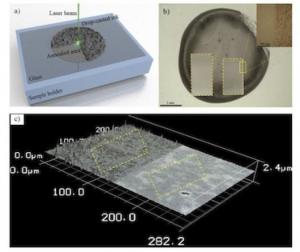German scientists at the University of Siegen, along with scientists from the KTH-Royal Institute of Technology in Kista, Sweden, claim that laser annealing can improve the quality of printed graphene (and other 2D materials) inks. This can be beneficial for various applications like flexible electronics devices, including batteries and supercapacitors, transistors, solar cells and displays.

The researchers succeeded in producing uniform, transparent and conductive graphene thin films by simply drop-casting dispersions of the carbon sheet onto a glass surface and combining this drop-casting step with laser annealing. The annealing process involves scanning a laser beam across the surface of the films, which distinctly improves their transparency and how well they conduct electricity.
The improved graphene inks are more than 85% transparent to 550 nm wavelength light, a value that is 45% higher than that of films which have not been laser annealed. They also have a sheet resistance of around 30 KΩ/cm, which is 70% lower than that of unannealed films. They are also much smoother than unannealed films.
The German researchers obtained their graphene inks using a solvent exchange technique that was developed by the Swedish team. To form multilayer graphene films, the researchers dispersed the graphene inks by drop-casting 1μL droplets onto a glass slide. After drying the inks, they baked the films at 400 °C for 30 minutes to remove the stabilizing polymer (this step is crucial for preventing the graphene flakes from aggregating during drying). Finally, the team scanned the films with a continuous wave 500 mW, 532 nm laser beam during 14 milliseconds over a spot size of 1 μm. The laser system was also set up to characterize the sample in situ during the processes (albeit at a lower laser power).
The team says that it is now busy looking at inks made from other 2D materials and that they are also experimenting with different lasers to speed up processing times.